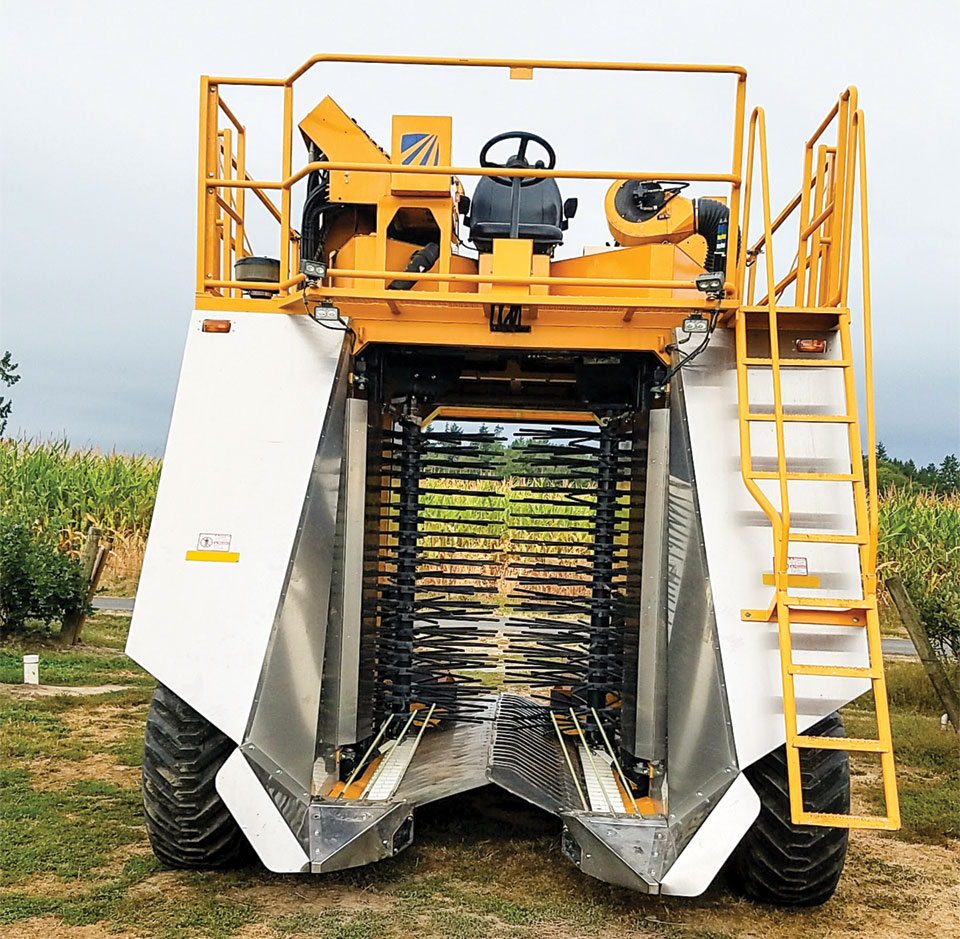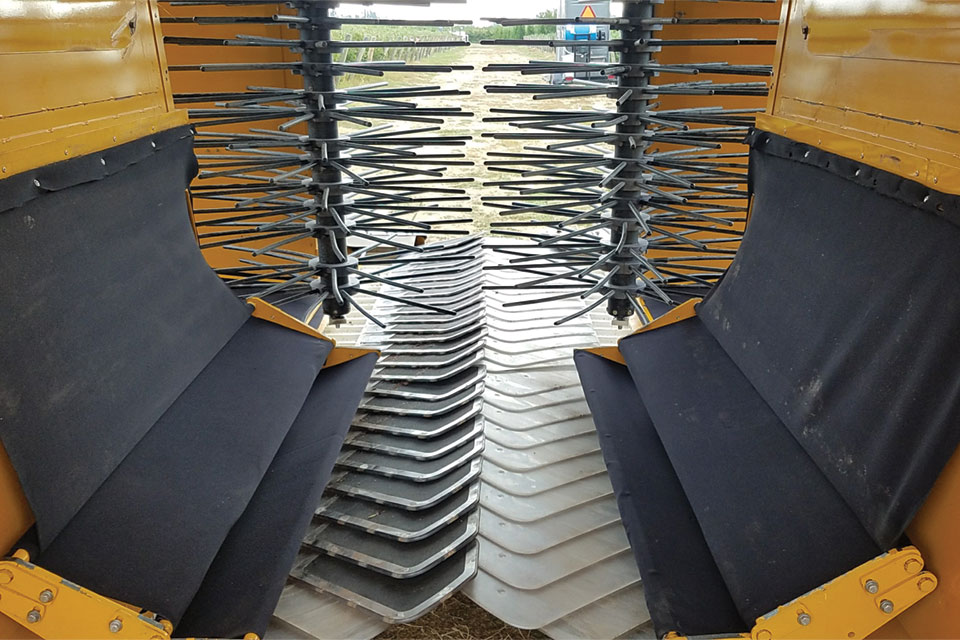More Advancements Made in Harvest-Assist Berry Project

Standard Orbirotor heads were included in the harvester trial as the research team seeks mechanized solutions that still produce fruit similar to hand-harvesting. (Photo: Lisa DeVetter)
A new semi-mechanical harvest aid system has been developed by a national team of experts as part of a project to improve the efficiency of harvesting fresh market highbush blueberries.
The new system is part of a project funded by the USDA Specialty Crop Research Initiative (SCRI), and was developed as a way for producers to efficiently harvest fruit with quality good enough for fresh-market pack-out. This year, the project team integrated the harvest aid system into an Oxbo harvester, showing that there is potential for improvement in mechanical harvesting technology.
The project has been led by USDA-ARS Horticulturist Fumi Takeda, with collaboration from the project team and harvesting manufacturing companies, primarily Oxbo International. The project team is co-led by Charlie Li, Professor of Engineering with the University of Georgia, and Lisa DeVetter, Assistant Professor of Small Fruit Horticulture with Washington State University. According to DeVetter, this national team possesses expertise in engineering, horticulture, plant pathology, postharvest physiology, food safety, ergonomics, economics, and Extension.
The project includes the development of the next-generation berry impact recording device (BIRD) and a low-cost berry harvest-assist system.
Implementing Research
DeVetter’s role is in working with the development of the harvest-aid system. She assists with testing the systems, primarily in Washington.
There have been several prototypes of the harvester, each one designed to be an improvement upon the last. This year, the system the team developed was integrated into an Oxbo 7420 over-the-row blueberry harvester. The resulting machine-harvested fruit was comparable to hand-harvested fruit, DeVetter says.
Later, during the summer, DeVetter and the team trialed another Oxbo 7420 harvester, this time removing the hand-held pneumatic shakers and replacing them with standard Orbirotor heads and modified catching surfaces. The resulting fruit were again comparable to hand-harvested fruit.
The results demonstrated that machine-harvesting technology for fresh-market blueberries can be achieved, DeVetter says.
“There is potential for advancements to be integrated into over-the-row (OTR) machines and utilized in commercial production, DeVetter says.

Modified catching surfaces and standard Orbirotor are shown on this Oxbo 7420 the research team trialed this past season. (Photo: Lisa DeVetter)
Research on Pneumatic Shakers
Initially, Takeda and the team were focused on creating modified catching surfaces and harvesting fruit using handheld pneumatic shakers.
“Essentially, there are soft-catching surfaces that are softer than the scales and conveyors that fruit drop on with a typical over-the-row harvester. These catching surfaces reduce bruising and are intended to promote fresh market quality and postharvest storage life,” DeVetter says.
The softer fruit-catching surfaces were not glued to the hard sub-surfaces, but suspended over them, Takeda explains. The new catch plates are patented, and the patent for its design was issued to USDA in 2017 (Takeda is one of the inventors listed on the patent).
DeVetter says the results to date have been “very promising,” and in many cases, the team has been able to achieve fruit quality comparable to hand-harvest.
Furthermore, the pneumatic shakers removed 3.5 to 15 times more fruit effectively than by hand, while the soft-catching surfaces reduced impact force and bruise damage, Takeda says. Ergonomic analysis by electromyography showed that muscle strain in the back, shoulders, and forearms was low in workers operating the pneumatic shakers that were tethered to the platform with a tool balancer.
According to Takeda, the new harvesting method can reduce the labor required to about 100 hours/hectare/year and help to mitigate the rising labor costs and shortages of workers for harvesting fresh market quality blueberries.
Decrease Labor Costs
“Ultimately, the goal of this project is to help develop harvesting technologies and supporting systems that would permit mechanized harvest of blueberry with fruit quality and postharvest storage life comparable to hand-harvested fruit,” DeVetter says. “This is important for growers facing an increasingly competitive marketplace, rising costs of production and increasing labor constraints for hand-harvest.”
Despite the fact that the blueberry industry has grown in the past three decades, there have been shortages of labor for hand-harvesting. This, along with increasing labor costs and low harvest efficiencies, is hindering sustainable development of the fresh market industry. Mechanical harvesters do help to reduce harvesting costs, but they can result in lower yields and poor fruit quality. Beyond that, the harvesters are often unaffordable for small- to medium-sized producers.
According to Takeda, research into mechanical harvesting of blueberries with over-the-row machines has been ongoing since the 1950s. However, due to several design limitations of these harvesters and problems with damage to fruit during the harvesting process, delivery to fresh markets and postharvest longevity have been a problem.
The team believes that an affordable harvesting system that maintains fruit quality and reduces ground loss would be embraced by stakeholders of all farm sizes.










